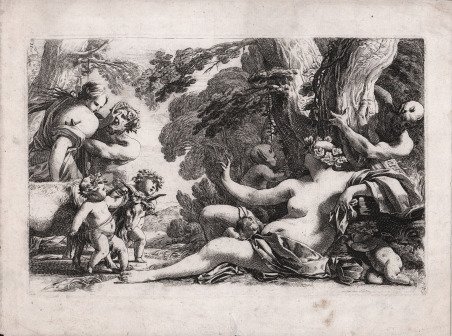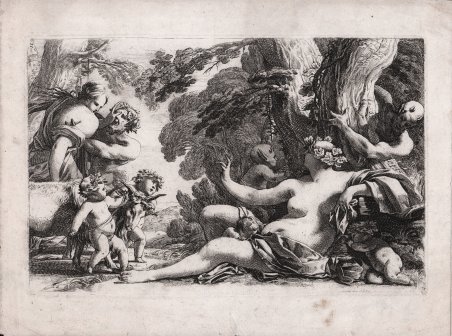Acquaforte e bulino, 1650 circa, priva di firma. Questa tavola appartiene alla suite di ' Baccanalia ' descritte da Robert- Dusmenil (IV, 12-17) ' il cui frontespizio, inciso da Nicolas Cochin il Vecchio recita “Recueil de diverses Baccanales de Poussin, Chapperon, D’origny et autres”. Tutte le stampe della serie contengono gli indirizzi dei rispettivi editori ma non i nomi dei disegnatori e degli incisori, il che rende difficile attribuire definitivamente le opere ad artisti specifici. Le stampe furono probabilmente pubblicate per la prima volta dagli editori François Langlois, noto come 'il Ciartres' (1589 Chartres - 1647 Parigi), e Philippe Huart (attivo intorno al 1639-1648) e furono seguite da una seconda edizione pubblicata da Pierre Mariette. I disegni per le incisioni potrebbero provenire da Nicolas Chaperon o dallo stesso Dorigny. Sei tavole della suite, benché prive della firma dell’autore, per ragioni stilistiche, sono riconducibili a Dorigny, autore di un’altra suite di ' Baccanalia, composta anch’essa da sei lastre, tutte recanti la sua firma (Robert-Dusmenil, IV, 6-11). Incentrate sulle attività di Bacco, Sileno e la loro allegra compagnia, queste due serie di affascinanti composizioni all'acquaforte dimostrano la ricchezza e la destrezza dei poteri di invenzione di Dorigny. In contrasto con la maggior parte delle sue prime interpretazioni delle opere di Vouet e altri, dove spesso usava il bulino per aumentare leggermente la sua vigorosa acquaforte, alcune delle stampe successive di Dorigny, in particolare queste due suite di baccanali, si affidano ancora di più al bulino. Questa tendenza è parallela a un graduale cambiamento nel suo disegno, che rivela una crescente tendenza verso contorni pronunciati e figure più scultoree. Dopo essersi formato per cinque anni sotto Georges Lallemand a Parigi, Michel Dorigny si unisce presto alla cerchia del pittore Simon Vouet, con il quale stringe un'amicizia stretta e duratura. Dorigny divenne in seguito uno dei principali interpreti in campo tipografico dell'opera pittorica di Vouet e fu anche coinvolto come pittore in diversi progetti artistici del maestro. Le sue stampe comprendono opere su temi religiosi e mitologici così come stampe singole e serie su temi dionisiaci. Le suite probabilmente risalgono agli anni ’50 del XVII secolo, dopo la morte di Vouet. Bellissima prova, ricca di toni, impressa su carta vergata coeva, con margini, in ottimo stato di conservazione. Bibliografia Robert-Dusmenil, IV, p. 254, 14: Reed, ' French Prints from the Age of the Musketeers, p. 233. Etching and engraving, 1650 circa, numbered 11 at lower left. After training for five years under Georges Lallemand in Paris, Michel Dorigny soon joined the circle around the painter, Simon Vouet, with whom he struck up a close and lasting friendship. Dorigny subsequently became one of the main printmaking interpreters of Vouet’s painted oeuvre and was also involved as a painter in several of the master’s artistic projects. His prints include works on religious and mythological themes as well as individual prints and series on Dionysian topics. It is to this latter category that six etchings belong which Dorigny produced together with Nicolas Chaperon and other artists for the series entitled Recueil de diverses Bacchanales (Robert-Dumesnil, vol. IV, p. 254, nos. 12–17). All the prints in the series contain the addresses of the respective publishers but not the names of the designers and engravers, which makes it difficult to definitively ascribe the works to specific artists. The prints were probably first issued by the publishers François Langlois, known as ‘il Ciartres’ (1589 Chartres – 1647 Paris), and Philippe Huart (active around 1639–1648) and were followed by a second edition published by Pierre Mariette. The designs for the etchings may well stem from Nicolas Chaperon or from Dorigny himself. Another suite of six bacchanals (Robert – Dusmenil 6-11) bears on each plate the name of D’Origny as engraver. Both suites probably date to the 1650 when, after Vouet’s death, Dorigny became one of the most important decorative painters in Paris. Focused on the activities of Bacchus, Silenus, and their merry band of associates, these two etched sets of charming compositions demonstrate the wealth and dexterity of Dorigny's powers of invention. In contrast to most of his earlier interpretations of the works of Vouet and others, where he often used engraving to lightly augment his vigorous etching (see cat. 102), some of Dorigny's later prints, espe- cially these two suites of bacchanals, rely even more on engraving. This trend parallels a gradual shift in his draftsmanship, which reveals an increasing tendency towards pronounced contours and more sculptural figures. A fine impression, printed with tone on contemporary laid paper, with margins, very good condition. Bibliografia Robert-Dusmenil, IV, p. 254, 14: Reed, French Prints from the Age of the Musketeers, p. 233. Cfr.


Descubre cómo utilizar
Descubre cómo utilizar

